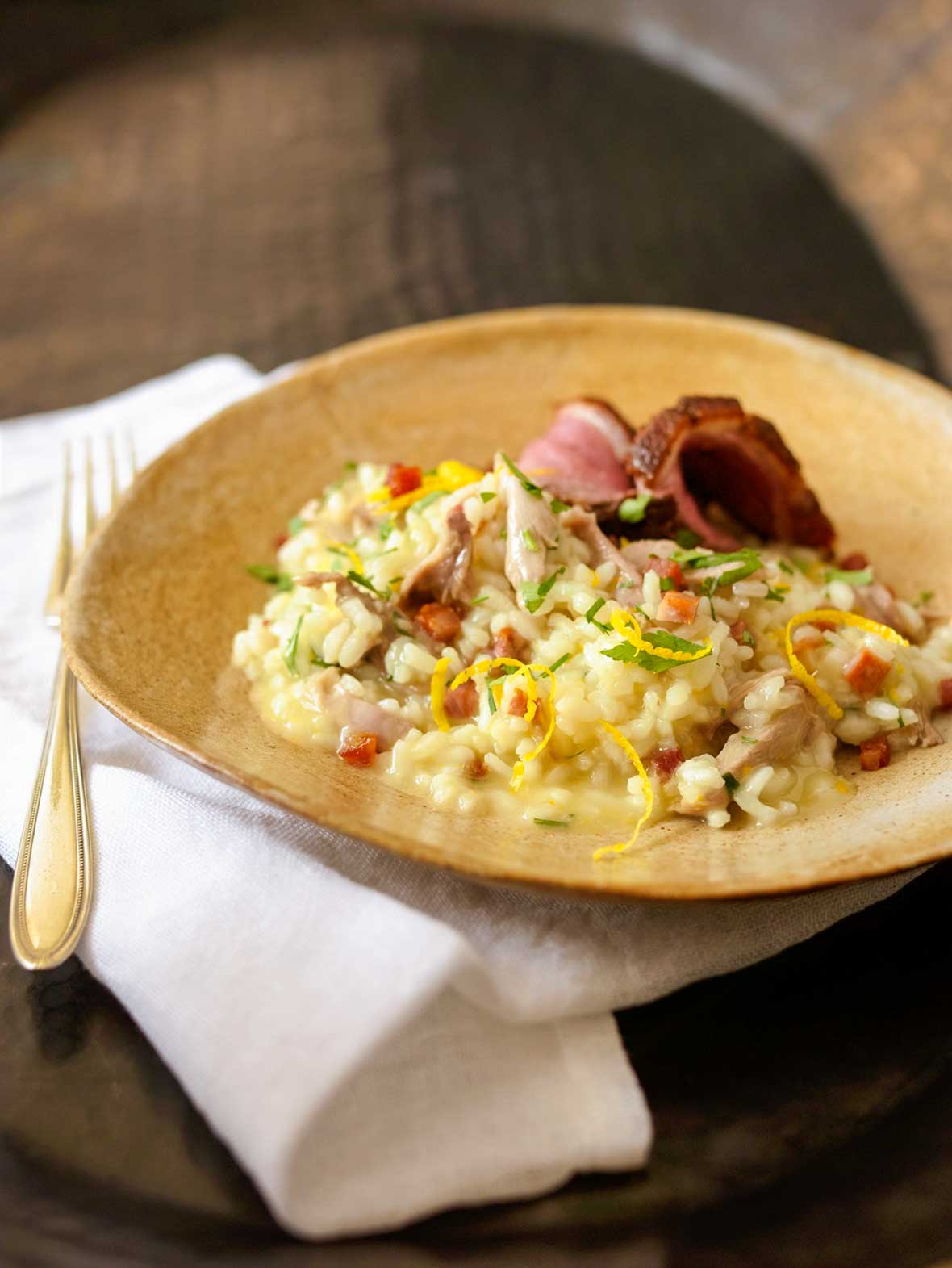
Arroz de pato, or duck with rice, is a specialty of the Minho region. Traditionally, it’s made by first boiling and then roasting duck to cook it to tenderness and make a rich stock, then later roasting the shredded meat along with rice. But I find this technique often leaves the bird flavorless and dry. Plus, it takes an entire day of waiting to chill the stock and then degrease it.
This cheaters’ version of the dish is inspired by a risotto made by my friend, chef Vitor Veloso. It calls for braising the legs in chicken stock, then shredding the meat and stirring it into a creamy risotto made with the de rigueur ingredients, including presunto (cured ham), chouriço (spicy sausage), and orange zest. Adorning the top are slices of perfectly seared duck breast. Much faster, infinitely easier, and far more sophisticated.–David Leite
How to make flavorful duck risotto
Risotto has the potential to send people shrieking into the hills. And for what? It’s really a cinch to make a great pot of risotto. All you need is patience and a lot of broth. I’ve made this risotto more times than I can count.
But a few weeks ago, I was rushed, and I did the unthinkable–I resorted to a bargain brand of canned chicken broth, and I bought some duck on sale. Needless to say, the dish had nary a hint of flavor.
Properly chastened, I made it again shortly thereafter, but this time, I returned to my old duck standby, D’Artagnan, which I’d used previously. Then I made a duck stock out of some excellent chicken stock along with D’Artagnan’s Duck and Veal Demi-Glace and two of their moulard legs and a magret half-breast.
This time, the risotto was as I’d remembered: sensational. I don’t often mention brand names, as it feels like a commercial, but considering how much better the dish was, I believe it’s my duty. I also believe D’Artagnan is well worth the price. Carry on.
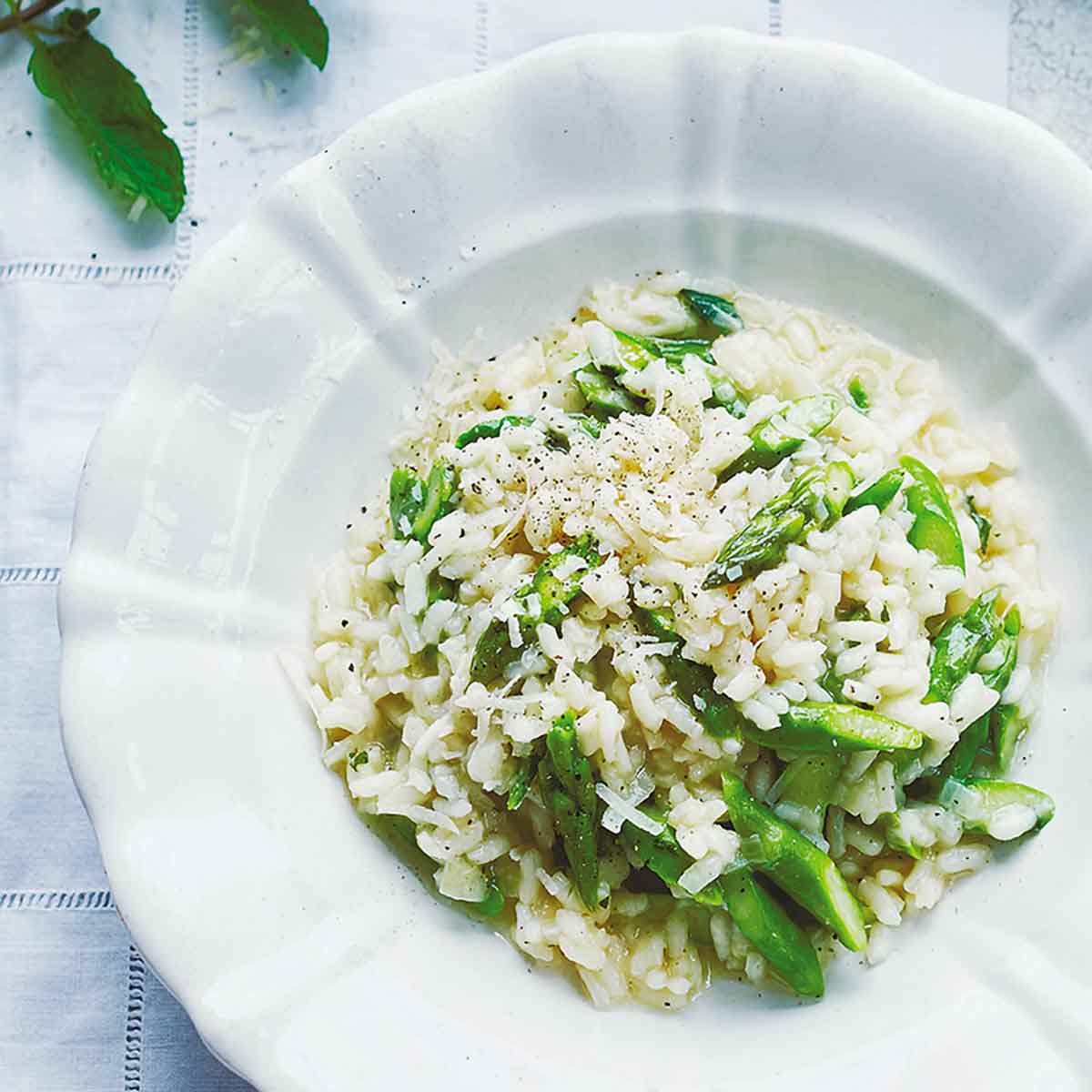
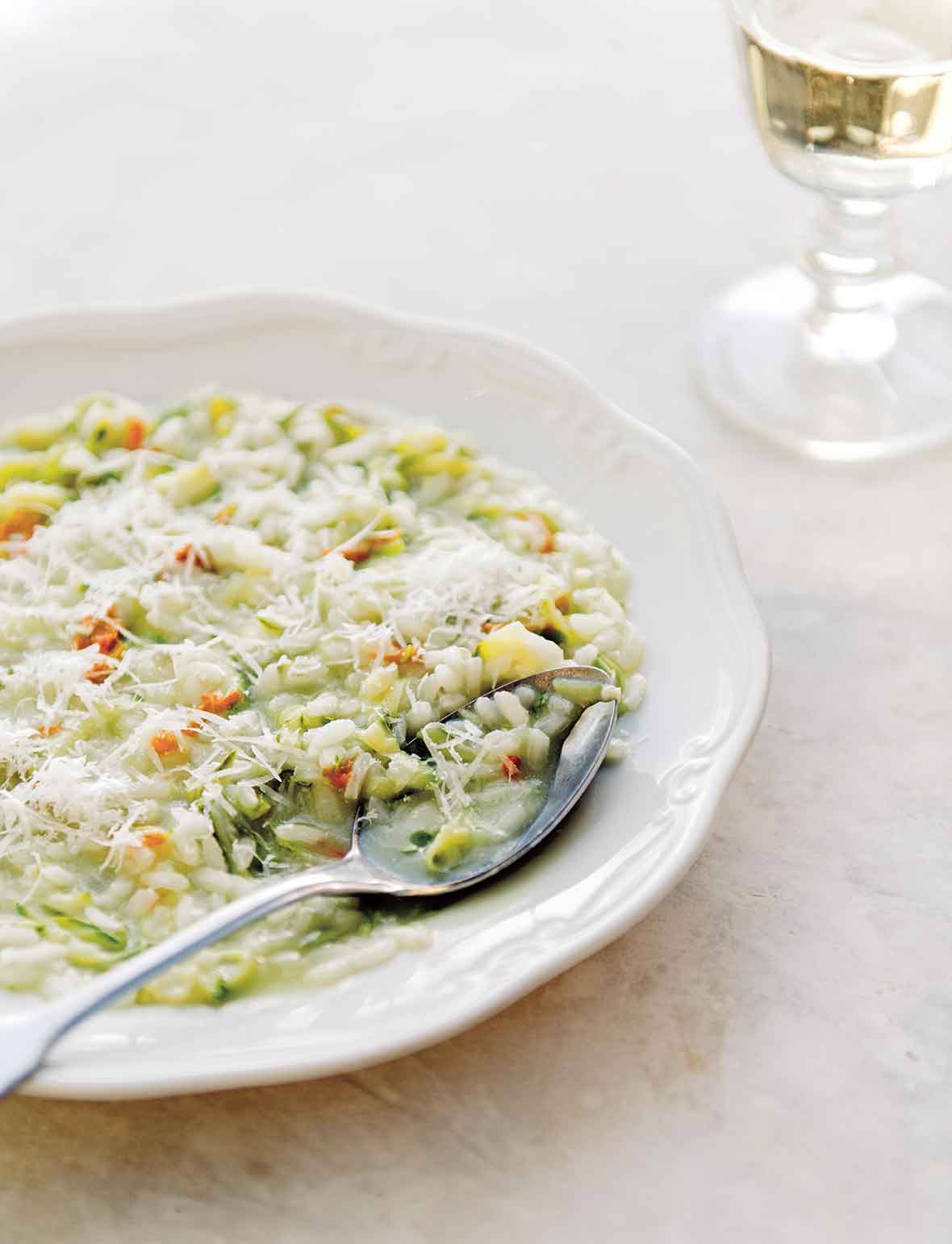

Portuguese Duck Risotto | Arroz de Pato
Ingredients
- 1 tablespoon olive oil
- 2 (1 1/4 lbs) duck legs, trimmed of excess fat
- Kosher salt and freshly ground black pepper
- 6 to 8 cups homemade chicken stock or low-sodium canned chicken broth
- 3 ounces chouriço, linguiça, or dried-cured smoked Spanish chorizo, cut into 1/4-inch (6-mm) cubes
- One (16-ounce) boneless moulard duck breast half
- 1 small yellow onion, minced
- 2 cups Portuguese Carolino or Italian Carnaroli or Arborio rice
- 1/2 cup dry white wine
- One (1/4-inch) thick slice presunto, Serrano ham, or prosciutto, excess fat removed and cut into 1/4-inch cubes
- 2 tablespoons fresh orange juice
- 1 tablespoon (1/2 oz) unsalted butter
- Minced fresh flat-leaf parsley leaves, for garnish
- 1 to 2 tablespoons grated orange zest, preferably organic, to taste
Instructions
- Heat the oil in a large skillet over medium-high heat. Season the duck legs well with salt and pepper. Place the duck legs in the skillet, skin side down, and sear until lightly browned, about 5 minutes per side.
- Transfer the legs to a medium pot off the heat. Drain the fat from the skillet (and by all means, reserve this liquid gold for another use). Set the skillet aside.
- Add enough of the stock to the pot to cover the duck, bring to a simmer, and cook, covered, over low heat untl the meat is tender, 1 to 1 1/2 hours.
- Meanwhile, sauté the chouriço in the reserved skillet over medium heat until the fat is rendered, about 5 minutes. Using a slotted spoon, transfer the chouriço to paper towels to drain.
- Remove the duck legs from the pot and transfer to a plate. When they’re cool enough to handle, remove the skin, pull the meat from the bones, and shred into bite-size pieces. Spoon the fat from the top of the stock and add the remaining stock to the pot. Bring to a simmer over medium-low heat and keep it bubbling gently.
- Heat the oven to warm (about 160°F [70°C]) Place a wire rack on a rimmed baking sheet.
- Using a razor-sharp knife, score the skin of the breast in a crosshatch pattern, being mindful not to cut into the flesh. Pat it dry and season with salt and pepper. Wipe out the skillet and place it over medium-low heat. Add the breast, skin side down, and sear until crisp, allowing the fat to render slowly, 10 to 15 minutes. Don’t rush this–the last thing you want is a mouthful of chewy fat.
- Flip and sear the other side for 3 to 4 minutes. Transfer the duck to the rack in the oven to keep warm. While in the oven, the breast should reach medium-rare, about 135°F (57°C) on an instant read thermometer.
- Drain all but 3 tablespoons of fat from the skillet and return it to medium heat. Add the onion and cook, stirring occasionally, until softened, about 5 minutes.
- Add the rice, stir to coat, and cook until translucent around the edges, about 2 minutes. Splash in the wine and continue cooking until it’s absorbed. Add a ladleful of hot stock and cook, stirring continuously, until the liquid has almost burbled away. Keep up this rhythm of adding stock, stirring, and cooking for 15 minutes, then stir in the presunto and chouriço.
- Add the shredded duck to the risotto and resume the ladling, stirring, and cooking until the rice moves wave-like when mounded, is ultra-creamy and tender, and offers just the slightest bit of resistance in the middle, 5 to 10 minutes more. A classic risotto has a loose consistency, meaning if you wobble the pot or bowl, the risotto will slump and spread. At least, that’s what results when the liquid has been added patiently and properly.
- Remove the risotto from the heat, stir in the orange juice and butter, and season with salt and pepper to taste.
- Slice the duck breast crosswise into thin slices. Divide the risotto among warm shallow bowls (simply run them under hot, hot water and dry them quickly or, if ovenproof, warm them in a low oven) and arrange the slices of breast on top. Sprinkle with the parsley and orange zest. Rush to the table. Originally published October 11, 2010.
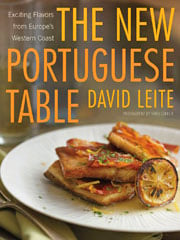
Explore More with AI
Nutrition
Nutrition information is automatically calculated, so should only be used as an approximation.
Recipe Testers’ Reviews
I made this recipe last night for my husband’s birthday dinner. I admit, I was a tad skeptical, as he’s not a big risotto fan and he loves the Portuguese rice with duck that I have made for years. So you may be wondering why I chose to do this for his birthday. Well, as I was reading the recipe, it all made sense, and I could fully imagine that, though this is a different recipe than the traditional Portuguese dish, I knew the familiar flavors would still be there. The end result? A very happy husband—and two very happy daughters—who filled their plates twice!
Just as I was hoping, the flavors were there and it was very creamy, yet it was a much nicer and more sophisticated dish than the traditional. It was also much less heavy of duck fat. The breasts were outstanding. Now a few things I did differently: I bought a whole duck which was not very big, so I used both breasts. With its bones I made the stock, so did not use the chicken stock. I did use 2 tablespoons orange, but next time will only add 1 tablespoon.
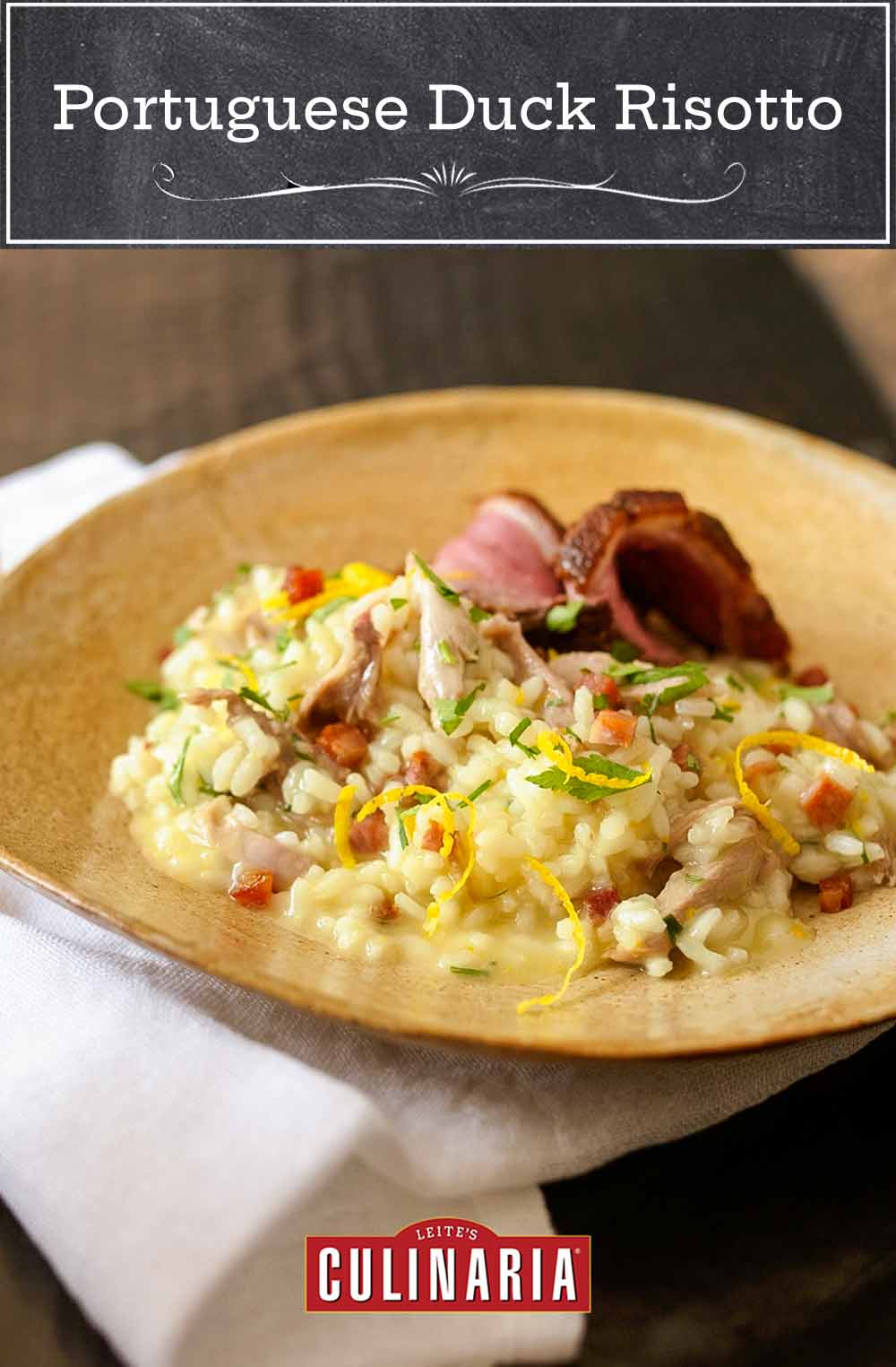











I have made this recipe 3 times now. You cannot rush this but I promise it will be well worth it! So set aside a few hours in the kitchen for this labour of love. Also, I think anyone regardless of kitchen skill level can take this on. Please don’t feel intimidated if you’re not a chef! The results are a very flavourful and delicious dish. Well worth the effort. Thank you David for this wonderful recipe that I will continue making and bragging about!
Monica, you’re more than welcome. I’m delighted that you enjoy this recipe so much, and I’ve made it multiple times. Obrigado!
Monica,
I too have made this recipe many times since first testing and let me tell you, I even got marriage proposals!! This is the absolute PERFECT recipe if you want to WOW someone.
That’s fantastic, Sofia! Thank you!
Thank you for the recipe. I made a version of this dish using duck I smoked from a local Amish farm, and also used homemade ham. It was very good.
Wow! That’s gorgeous, PedroPub. Thanks so much for taking the time to share your photo with us.
Actually, I don’t find arroz de pato that difficult to make, but it does take some time, I’ll give you that. But it’s so delicious it’s worth the time. Besides, Portuguese cooking in general is slow cooking, you gotta take your time.
Absolutely, arroz de pato is fantastic when done correctly. Rui, do you have a recipe you might want to share with readers?
Well, that recipe is all over the net, it’s not really a secret. lol. I liked this one. This is the most typical version. In some places, they make it this way. In Lisbon, where I used to lived, I’m in Brussels now, the first one is what you can find anywhere.
Enjoy.
Well, the Portuguese arroz de pato is not a risotto, so I don’t understand the comparison. And if well done, it’s never dry and definitely never flavorless. Rui from Lisbon.
Hi Rui, thanks for writing. I didn’t say arroz de pato is a risotto dish, because it’s not. The preparation is completely different. As you can see, the name of this dish is “Portuguese Duck Risotto,” and is based upon a dish by chef Victor Veloso. I’m not comparing the dishes; I just was referencing arroz de pato so readers got a sense that it’s a classic dish and from whose flavor profiled Vitor borrowed. I chose to go with Vitor’s dish, rather than arroz de pato because it’s easier and faster for most home cooks.
I wasn’t trying to imply the dish is dry and flavorless–just the duck meat after cooking. I’ll concede that it could definitely be the duck we get here in America as compared to those in Portugal. (I have the same problem with pork. The pork in Portugal is far, far superior to anything the average cook can get here.)
But I can see how the headnote could be confusing, so thank you. I’ve rewritten it to make it clearer.